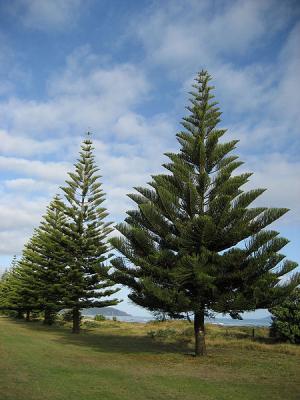Australian Pine

Araucaria heterophylla, also known as House Pine, Australian Pine, Norfolk Island Pine and simply Norfolk Pine (the latter being the most common) is a popular cultivated species of tree. The distinctive appearance of this tree, with its widely spaced branches and symmetrical, triangular outline, has made it a desirable choice for decorative landscaping, use as a houseplant and display as a Christmas tree. Large numbers of Norfolk Island Pines are produced annually in South Florida for the houseplant industry. The vast majority of these are shipped to grocery stores, discount retailers and garden centers during November to be sold as Christmas trees.
The toxic components of the tree are unknown and the actual danger it poses is somewhat disputed.There is very little documentation regarding the plants specific effect on companion animals and most sources refer to the danger or lack thereof it poses to humans. The IWK Regional Poison Centre in Halifax, Nova Scotia considers the plant to “be safe or non-poisonous” noting that only real danger is poses is as a choking hazard to small children. Other sources consider the plant to be mildly toxic and capable of causing localized dermatitis in some individuals when it comes into contact with the skin and gastrointestinal upset if ingested. With pets specifically, the few sources available of questionable credibility state that the “ingestion of pine needles can cause gastrointestinal signs (vomiting, diarrhea) and lethargy”.
As the tree is not a natural food source for any companion animal, it is likely that any number of naturally occurring plant chemical present in the plant could disagree with the companion animal that choose to ingest it. This is not a phenomena that is unique to this plant specifically as dogs and cats alike will commonly ingest other plants, grasses etc and promptly vomit them up as well.
The greatest danger posed by this plant probably comes from its use as a Christmas tree, in which case it will generally be placed in some sort of stand containing water. Water that may accumulate numerous types of bacteria or mold and may even contain chemical fertilizers; all of which could make a pet very ill. Additionally it is not uncommon for many retailers to spray any number of potentially harmful or lethal chemicals on the tree to extent its longevity or enhance its appearance prior to sale; chemicals which would inevitably leach into the water. As with anything that could potentially harm your pet, exercise caution and common sense when it is in an area where a pet could access it. Ensure your pets have plenty of fresh water available to them, to dissuade the urge or need to drink from the Christmas tree stand. If possible place presents, screen, or decorative fencing around the tree in such a way as to prevent pets from accessing, what to them seems like a perfectly good water source.
Avoid further ingestion of the plant and consult a veterinarian. Life threatening intoxication from ingestion of the plant is basically unheard of, fatalities, while theoretically possible would likely come from choking and not the over ingestion of toxic plant chemicals. In regards to a specific treatment regimen for illness relating to the ingestion of the plant common sense symptomatic care will probably be all that is required. If the ingestion was recent remove any existing plant matter from the mouth and flush thoroughly with water. If vomiting does not occur it may be induced by giving and emetic such as 3% hydrogen peroxide orally at a dose rate of 1 teaspoon per 10 lbs of body weight. The pet will more than likely start vomiting spontaneously without the help of an emetic, as their body tries to expel this non digestible material. The universal antidote, activated medical charcoal may also prove to be of some use in absorbing the toxins. If the pet ingested a large quantity of plant material then it may be beneficial to empty the stomach contents by way of gastric lavage.
Ensure the pet gets plenty of fluids to avoid possible dehydration caused by diarrhea. To alleviate the gastrointestinal upset and diarrhea; Kapectolin may be given at a dose rate of 1 to 2 ml/kg four times a day. Kapectolin provides a coating action that protects the stomach lining. Sucralfate may also be used as for gastrointestinal irritation as it reacts with the acids in the stomach to form a paste-like material capable of acting as a barrier between the stomach and its contents. Sucralfate is typically given to dogs weighing more the 60lbs: 1g every 6 to 8 hours; for dogs under 60 lbs: 0.5g every 6 to 8 hours; Cats: 0.25g every 8 to 12 hours to reduce irritation of the stomach and intestines. The prognosis will depend on the amount ingested and the resultant severity of the intoxication. Serious intoxications of animals are exceptionally rare and in most cases symptoms will be limited to gastrointestinal upset (vomiting and diarrhea). With symptomatic care most animals will make a full recovery in a few hours to a few days.
In situations where the pet may have fallen ill from drinking water intended to nourish the tree such as from the tree stand of a Christmas tree, the symptoms, severity, and prognosis could vary widely depending upon what the exact component was that made the pet sick, (eg. bacteria, mold, fertilizers, other unknown chemicals). Consult your veterinarian or a pet related poison control center.




